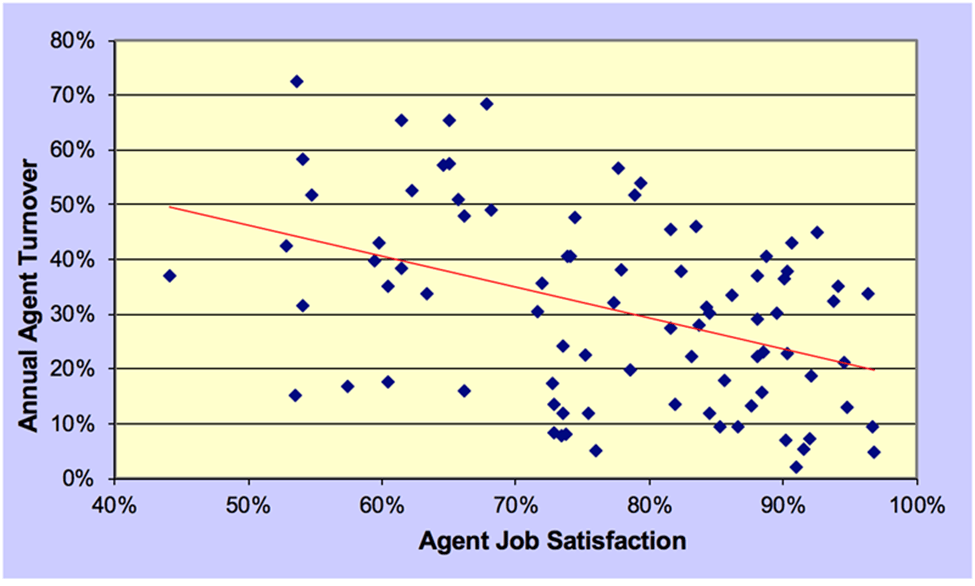Employee engagement has long been an issue for BPO companies, but never more so than in today’s post-pandemic world of hybrid and remote work.
Among the companies we interviewed, we found that they shared common problems that emerged as a result of poor employee engagement levels. These included a lack of productivity, reduced customer satisfaction and retention, and increased employee attrition.
According to a McKinsey report, an engaged employee is 8.5 times more likely to remain in their job, and 16 times more likely to recommend their employer to a friend. This just goes to show how important it is to pay attention to employee engagement levels.
A recent ICMI report reinforces this by showing a clear correlation between employee satisfaction and staff turnover. Those who report they are more satisfied with their job – that is, those people who are more engaged – are considerably less likely to quit.

In that case, how can Time Doctor benefit my company?
Through an array of features and sophisticated tracking capabilities, Time Doctor can provide your BPO company with the tools it needs to thrive in this ever-evolving world, and to wave goodbye to issues surrounding employee engagement.
Read on to find out why the employee disengagement problem is a real issue for BPOs, and how various real-world companies have employed Time Doctor to grow to lofty new heights.
The challenges
We found that many BPOs are facing issues with employee engagement, and that it’s a much more widespread problem than previously thought.
Below are some of the main challenges encountered by BPOs which are all strongly linked to employee engagement.
Remote work
The main challenge facing companies today is the transition to remote working. In the pandemic’s aftermath, a large percentage of BPO employees now work remotely, often across multiple countries.
A staff leasing company that uses Time Doctor employs a lot of offshore talent, and long felt like they were missing signs of employee disengagement. They wanted a clear overall picture of how their employees felt, so they could successfully ensure the wellbeing of both their staff and clients.
Customer service outsourcing company Eufonie encountered a similar problem. They’re a BPO based in Madagascar, who recently made the transition to remote working. As a result, they needed software that could reliably track and assess their employee engagement levels in this new environment.
Burnout
A major factor that influences employees’ engagement levels is wellbeing. All too often, BPO employees are faced with rigid schedules, potentially stressful interactions, and client deadlines. These can easily lead to overworking and burnout.
Research suggests that burnout is a leading cause of employee turnover, with around 10% of HR leaders attributing it as the primary factor behind over 50% of their company’s turnover. What’s more, burnout affects every single one of us.
The key to managing burnout is understanding work-life balance. If leaders know who is at risk of overworking or suffering stress, they can take action. High performers, for example, are often more susceptible to burnout because they tend to be more diligent and in demand, and therefore, under more pressure.
While it is easier to sense struggling colleagues if everyone is in the office, supporting people while enabling more flexible remote or hybrid models requires sophisticated digital tools.
Visibility of work
Many BPOs are operating either fully or partially remotely. As a result of this, they and their clients need peace of mind that remote staff are logged in and doing their jobs effectively with reduced supervision.
Phoenix Virtual Solutions is one such company. As a BPO with bases in the Philippines and the US, they needed affordable software that could increase visibility and accountability across their workforce. Since they offer a virtual healthcare service, they also needed assurance that their remote staff were working efficiently and productively and were in compliance with regulations at all times.
This is important because, as accountability increases, so too does trust in employees. This allows companies to grant their staff more flexibility with working hours and where they work from, which is proven to reduce employee attrition. According to The Hustle, a lack of flexible or autonomous working options is a leading factor into why people choose to leave their jobs.
Employee experience
Adequate training and access to appropriate tools to do their jobs are things that employees value highly, but often go overlooked by management staff. Around 56% of call centers disregard active improvements to their staff training, according to a CCW Digital survey.
Personiv, an award-winning BPO company that offers a range of digital services, found that they were increasingly unaware of their employees’ work habits with regards to what software they most utilized. As they expanded, so too did their expenditure on licenses. But they had no real way of monitoring if they were worth paying for.
The solution
Employee engagement can be improved in any number of ways. With a hybrid and remote workforce, it is important to have digital tools available that you can use to both facilitate, manage, and measure engagement. The benefits of these tools can also be felt in the office, as roles become more demanding, technology more complex, and the economic environment pushes companies to improve productivity.
Time Doctor is one such tool. More than just a time tracking and monitoring tool, it brings an array of benefits and opportunities for enhancing not only staff engagement, but also customer retention, employee satisfaction, and productivity.
For BPOs the benefits of improved employee engagement are improved client satisfaction. In BPOs many staff members have direct contact with clients, certainly from Team Leader level upwards. For staff leasing BPOs clients are your employees’ line managers, so they work closely with them all day. It quickly becomes clear to a client when an employee is disengaged.
Find out how Time Doctor has benefited real-life companies below.
Employees become reinvigorated
Even for Time Doctor’s own team, it’s important to note our employees’ wellbeing and help them out where necessary. By using our own time-tracking software, Time Doctor’s engineering team was able to see in real time which employees were being overworked, with insights directly on the home dashboard.
As a result of understanding the team’s work patterns and productivity two more engineers were hired. This vastly and visibly reduced the stress of the team, as the workload was subsequently lighter and more manageable. Current employees experienced a reduction in stress levels and an increase in engagement, improving the likelihood of them remaining with the company.
Enhanced accountability and integrity
Time Doctor produces real-time reports of employee productivity. This, in turn, means that management can give team members more autonomy and flexibility in their work, as they feel their employees’ work is well accounted for.
BPOs like Phoenix Virtual Solutions, Eufonie, and Prialto all chose Time Doctor to improve their accountability to their clients. Only Time Doctor could provide their management and clients with the relevant data insights and screencasts detailing the output of their remote staff. This reassured their clients that their remote teams were working efficiently, effectively and compliantly.
“Time Doctor brought us more than just monitoring,” remarked Johan le Bail, founder and CEO of Eufonie. “Now we can give our clients more control and visibility than when we were previously able to in-office.”
Another company with productivity worries was 2nd Office. Since they started using Time Doctor, their productivity has increased by 10-20%, and they are now confident that their employees are performing well even in autonomous environments.
Better-trained staff
To improve employee engagement, it’s vital that staff have everything they need to do their job effectively. Time Doctor can uncover insights into how each employee works, providing employees themselves with valuable insights into their own productivity levels. With help from their managers, they can analyze their performance, compare it to the performance of their peers, and learn how to do their jobs in the most efficient way possible.
Rationalize costs
But it’s not just about acquiring the right tools for the job, it’s also about removing the wrong tools. With Time Doctor’s Web & App Usage feature, you can accurately track which software your employees utilize most often, and which ones are just collecting dust.
The team at Personiv was able to save a six-figure sum in software license by doing exactly that. With the help of Time Doctor’s Web & App Usage tool, they found that around 70% of their graphic design software apps were going unused.
“We used to have a couple hundred licenses of a popular graphics design app, and now we have less than 50,” notes Michael de Asa, the Head-Senior Director of Information Technology at Personiv. He adds that only Time Doctor provided them with the data needed for this invaluable insight.
Engage your employees with Time Doctor!
Employee engagement might seem like an uncontrollable problem, but there are ingenious ways to solve it. With Time Doctor, you’ll not only see a spike in employee engagement, you’ll also benefit from increased productivity, client satisfaction, and overall profit.
With over 140,000 users across thousands of satisfied companies, Time Doctor has consistently provided BPOs with the right software to improve flexibility and foster a nurturing environment.
Sophisticated time-tracking software and unbeatable data insights combine to produce impressive results and inject a new lease of life into any BPO, whether you’re making the transition to remote working or hybrid working, or just looking for ways to respond to your clients’ more complex demands.
So book a demo today!


